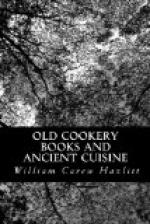The beer, which was an invariable part of the menu, was perhaps brewed from hops which, according to Harrison elsewhere quoted, were, after a long discontinuance, again coming into use about this time. But it would be a light-bodied drink which was allotted to the consumption at all events of Masters Thomas and Ingram Percy, and even of my Lady Margaret. It is clearly not irrelevant to my object to correct the general impression that the great families continued throughout the year to support the strain which the system of keeping open house must have involved. For, as Warner has stated, there were intervals during which the aristocracy permitted themselves to unbend, and shook off the trammels imposed on them by their social rank and responsibility. This was known as “keeping secret house,” or, in other words, my lord became for a season incognito, and retired to one of his remoter properties for relaxation and repose. Our kings in some measure did the same; for they held their revels only, as a rule, at stated times and places. William I. is said to have kept his Easter at Winchester, his Whitsuntide at Westminster, and his Christmas at Gloucester. Even these antique grandees had to work on some plan. It could not be all mirth and jollity.
A recital of some of the articles on sale in a baker’s or confectioner’s shop in 1563, occurs in Newbery’s “Dives Pragmaticus”: simnels, buns, cakes, biscuits, comfits, caraways, and cracknels: and this is the first occurrence of the bun that I have hitherto been able to detect. The same tract supplies us with a few other items germane to my subject: figs, almonds, long pepper, dates, prunes, and nutmegs. It is curious to watch how by degrees the kitchen department was furnished with articles which nowadays are viewed as the commonest necessaries of life.
In the 17th century the increased communication with the Continent made us by degrees larger partakers of the discoveries of foreign cooks. Noblemen and gentlemen travelling abroad brought back with them receipts for making the dishes which they had tasted in the course of their tours. In the “Compleat Cook,” 1655 and 1662, the beneficial operation of actual experience of this kind, and of the introduction of such books as the “Receipts for Dutch Victual” and “Epulario, or the Italian Banquet,” to English readers and students, is manifest enough; for in the latter volume we get such entries as these: “To make a Portugal dish;” “To make a Virginia dish;” “A Persian dish;” “A Spanish olio;” and then there are receipts “To make a Posset the Earl of Arundel’s way;” “To make the Lady Abergavenny’s Cheese;” “The Jacobin’s Pottage;” “To make Mrs. Leeds’ Cheesecakes;” “The Lord Conway His Lordship’s receipt for the making of Amber Puddings;” “The Countess of Rutland’s receipt of making the Rare Banbury Cake, which was so much praised as her daughter’s (the Right Honourable Lady Chaworth) Pudding,” and “To make Poor Knights”—the last a medley in which bread, cream, and eggs were the leading materials.




